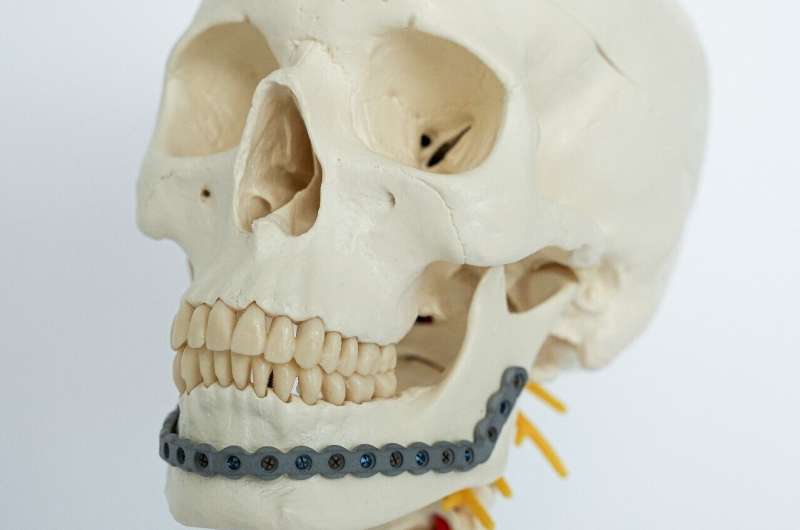Infectious complications are not uncommon after implant placement. The risk is higher in heavily contaminated wounds, which are particularly common in war zones such as Ukraine, where many bone injuries require treatment. Researchers at the Fraunhofer Institute for Manufacturing Technology and Advanced Materials IFAM in Bremen have developed a new functionalized surface that can be loaded with antibiotics.
Given the heavy burden on Ukraine’s health care system from numerous poorly healing fractures, Fraunhofer IFAM decided in 2023 to help. Beyond the current situation in the country, a personal factor was decisive.
“Two of our employees are from Lviv and were involved in the project from the very beginning. They made contact with the UNBROKEN national rehabilitation center in Ukraine, which we are now closely collaborating with to better understand local needs and further develop the technology in a targeted manner,” says Kai Borcherding, Head of Medical Technology and Life Sciences at Fraunhofer IFAM.
A special process creates pores on the implant surface
The researchers are using what is known as micro-arc oxidation (MAO) to produce a new type of surface on titanium implants. The metal parts are immersed in a conductive liquid—an electrolyte containing silver salts—and exposed to up to 300 volts. Within minutes, high‑energy plasma discharges form a silver‑doped oxide layer on the material, where targeted voltage application creates pores and incorporates silver nanoparticles. These reservoirs can then absorb antibiotics or other active substances, much like a sponge.
Local antibiotic administration and silver reduce the risk of infection
The researchers control pore size and structure by choosing the electrolyte and the process parameters. This is crucial for the loading capacity and the duration of antibiotic release.
“Once the MAO layer is complete, the metal parts are immersed in a highly concentrated antibiotic solution. Capillary forces ensure uniform filling of the pores up to the defined capacity with the drug, which is then released in the body by diffusion. After developing the surface and getting our project partners on board, we tested the antibiotic release profile over the desired period. For this purpose, we conducted in vitro tests at the institute,” says Linda Gätjen, Co-Head of Polymer Chemistry and Material Behavior at Fraunhofer IFAM. During lab testing, the researchers were also able to show that silver particles enhance the antibiotic’s effect.

Simple and fast coating process
This type of surface treatment is completely new in the field of implants: “Right now, there is nothing comparable on the market. Overall, there are only a few solutions for medical devices that rely on antibiotic coatings, and if they do, the production process is much more complex,” Borcherding says.
The simple setup, even under difficult conditions, is a major advantage of the method: Essentially, only a power supply and a cooling device for the immersion bath are needed for the MAO coating process. This makes the process so simple and cost-effective that it could even be used in crisis areas once the technology has matured further. In addition, the MAO surface shows excellent biocompatibility, supporting rapid implant integration.
Advancing the technology for Ukraine and beyond
How the new coating performs in practice will be tested in Ukraine. The next steps include preclinical development of the technology and clinical trials, which could be carried out at the UNBROKEN national rehabilitation center in Lviv. The center is the largest institution for hospital care of war-disabled people in Ukraine.
Since the beginning of the war, it has performed more than 10,000 operations. The center is in urgent need of safe implants, which is why UNBROKEN is planning to secure production capacity in the long term. At the moment, however, the team is still looking for partners in Ukraine and Europe to drive the project forward and produce prototypes on site.
The method is also attracting interest in Germany. As a technology partner of Fraunhofer IFAM, the company KLS Martin has already provided sample implants, which the Bremen-based researchers are currently working on—a first step toward application.
Tobias Wolfram, who heads the implant research department at KLS Martin, explains, “In addition to the high ethical value of the project, we see great potential in the MAO method for medical engineering, beyond bone implants. We are therefore happy to support the team with our expertise and materials.”
Fraunhofer IFAM will be presenting a human skull replica featuring titanium implants designed to prevent infections at the international trade show MEDICA, which will be held in Düsseldorf from November 17 to 20, 2025.
Citation:
Innovative surfaces to rapidly load bone implants with antibiotics (2025, November 3)
retrieved 3 November 2025
from https://medicalxpress.com/news/2025-11-surfaces-rapidly-bone-implants-antibiotics.html
This document is subject to copyright. Apart from any fair dealing for the purpose of private study or research, no
part may be reproduced without the written permission. The content is provided for information purposes only.

